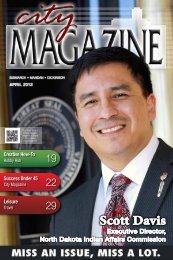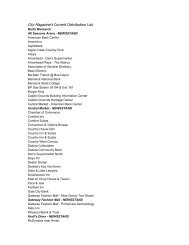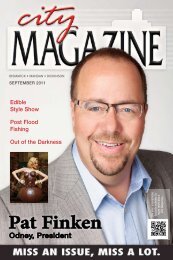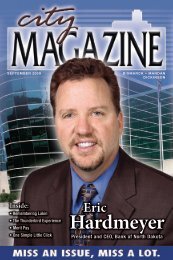Create successful ePaper yourself
Turn your PDF publications into a flip-book with our unique Google optimized e-Paper software.
CM SMARTS |<br />
Beginning Conversation:<br />
Healing America’s Health Care System<br />
A<br />
good conversation to have these days,<br />
with a variety of people, is about health<br />
care reform. It helps to understand how<br />
other countries’ health care systems<br />
work, to see what some options are.<br />
T.R. Reid, a Washington Post journalist, went<br />
on an expedition to research alternatives to our<br />
nation’s health care system, as well as hoping<br />
to treat his bum shoulder. His new book, “The<br />
Healing of America. A Global Quest for Better,<br />
Cheaper, and Fairer Health Care,” offers a picture<br />
of four different types of health care systems.<br />
Reid describes Britain’s National Health<br />
Service, inspired by Willliam Beveridge, as<br />
probably closest to what Americans imagine when<br />
they think of socialized medicine (Spain, Italy, and<br />
New Zealand also follow this model).<br />
In this model, the government is as responsible<br />
for taking care of people’s health as they are for<br />
picking up trash. It’s paid for with taxes. The<br />
government owns the hospitals, employs the<br />
doctors and nurses, buys the pills and pays the<br />
bills. Patients must see a general practitioner first<br />
and, if a specialist is needed, there’s a waiting line.<br />
Administratively, it’s simple because it cuts out the<br />
need for insurance.<br />
Germany, Japan, France, Belgium and<br />
Switzerland all utilize the “Bismarck Model”, which<br />
has all private doctors, hospitals and insurance<br />
plans. The difference is there are about 200<br />
non-profit insurance companies in Germany. It’s<br />
not single-payer, and you can drop it and switch<br />
companies, and they can’t raise your premium.<br />
By Candace Brannan Gerhardt<br />
The third type is the Canadian Model which<br />
is a blend of both the Beveridge and Bismarck<br />
Models. They have private doctors and private<br />
hospitals, but the payment system is public. In<br />
some provinces, people pay a premium; in some<br />
provinces, it’s a tax. But, you don’t get a hospital<br />
bill, so anybody can go.<br />
The last and most common model of health<br />
care operates on one rule: if you can pay your<br />
doctor out-of-pocket, you get treated. If you can’t<br />
pay, you stay sick or die. Brutal, but that’s the fact<br />
of life in most countries.<br />
In the United States, all four models exist.<br />
According to Reid, if you’re Native American or<br />
a veteran relying on government care, you live<br />
in Britain. If you share your health insurance<br />
premium with your employer, you live in Germany.<br />
If you’re a senior and you buy Medicare insurance<br />
from the government and go to a private doctor,<br />
you live in Canada. And, if you’re one of the tens<br />
of millions of Americans who can’t get health<br />
insurance, you live in Nicaragua or Honduras.<br />
Reid points out this difference: all other<br />
countries have decided that health care is a right,<br />
not a privilege, and these countries have decided<br />
that it’s more fair and affordable to provide one<br />
model where everyone has access to the same care<br />
at the same price.<br />
How should Americans reform our health<br />
care system? There are no easy answers, but we<br />
can’t ignore it any longer. Let’s look at it, and let’s<br />
continue this dialogue.<br />
November 2009 9
















